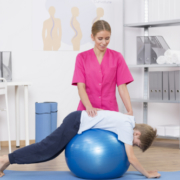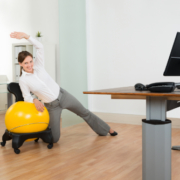3 Reasons Why Sitting On A Stability Ball Is Good For Your Spine
The workstation is one of the most damaging places you can spend your day when it comes to your spine. Office chairs are not designed to promote good posture or spinal health while desks and computer monitors are notorious for being too low or too high. The result can cause pain in your neck and back, headaches, and a variety of other conditions.
However, if you have a job that requires you to sit at a desk for an extended period of time, what can you do? Are you stuck with an achy, stiff neck and back because your work station doesn’t promote a healthy posture? You don’t have to suffer; you can work healthier and smarter. Using an exercise ball as your chair is a great way to combat the painful and even detrimental effects of the traditional desk and chair.
Stability Balls as an Office Chair
A stability ball, also known as a Swiss ball, exercise ball, or physio ball, is a large, inflatable ball that is used as training equipment. Regularly incorporating the stability ball into your fitness routine is effective in increasing pillar strength, improving your stability, and helping you have better balance. It is large, making it high enough that it can easily be used as a desk chair.
At least one company has combined the fitness benefits of a stability ball with some of the convenient features of an office chair (wheels, lumbar support, etc.). Gaiam Balance Ball Chairs are stability balls that are intended to be used as chairs. The ball needs to be inflated before use and may need to be re-inflated from time to time. It also has a 300-pound weight capacity. It is a somewhat pricier alternative to the plain stability ball.
How Sitting on a Stability Ball Benefits your Spine
There are at least three outstanding benefits you can enjoy by using a stability ball as your chair. Try it for just 30 days and see the difference for yourself. In that time you will see:
Your core muscles are toned. As you balance on the stability ball it forces you to engage your core muscles including those in your deep back, abdominal, and pelvic floor. It will keep your muscles engaged for extended periods of time but also encourage you to move for a little extra core work. This in turn will help to keep your spine properly aligned and stabilized.
Your back pain is relieved. Sitting on your stability ball improves your circulation, encouraging blood flow throughout your body. An office chair, on the other hand, does just the opposite. This is helpful in relieving pain. It keeps your spine aligned which also helps with any back pain you may experience. This is in part to the core strength you develop, but also because you are less likely to slouch or sit in a position that puts a strain on your back.
You have better posture. A better aligned spine just naturally leads to better posture. Sitting on the ball works your core, strengthening those muscles so that your spine is supported, resulting in better posture. You will find that you sit up straighter and over time you will walk taller. Better posture is very good for your spine, making it more flexible and stronger.
It should be noted that it isn’t healthy to sit in any position for too long. Stand up and move about every hour or so. While the stability ball causes you to change positions throughout the day, you also need the larger movements that include standing, stretching and walking.
Visit www.ocwc.ca to learn more about our clinic.







